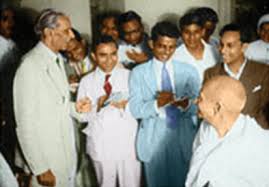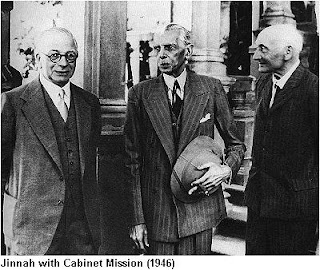Lord Pethick-Lawrence, Secretary of State for India on February 19, 1946, announced in Parliament that a special mission consisting of three Cabinet ministers, in association with the Viceroy, would proceed to India, in order to hold discussions with the Indian leaders. The three Cabinet ministers would be Pethick Lawrence, Sir Stafford Cripps and A.V. Alexander.
Cripps told the press conference on landing at Karachi on March 23 that the purpose of the mission was "to get machinery set up for framing the constitutional structure in which the Indians will have full control of their destiny and the formation of a new interim government." The Mission arrived in Delhi on March 24 and left on June 29.
Jinnah faced extreme difficulties in the three-month-long grueling negotiations with the Cabinet Mission. The first of these was the continued delicate state of his health. At a critical stage of the negotiations, he went down with bronchitis and ran temperature for ten days. But he never gave up the fight and battled till the end of the negotiations.
Secondly, the Congress was still much stronger than the Muslim League as a party. "They have the best organized -- in fact the only well organized -- political machine; and they command almost unlimited financial support…they can always raise mob passion and mob support…and could undoubtedly bring about a very serious revolt against British rule."-- Mountbatten's "Report on the Last Viceroyalty".
Thirdly, The Congress had several powerful spokesmen, while for the League Jinnah had to carry the entire burden of advocacy single-handedly.
Fourthly, the Mission was biased heavily in favor of the Congress. Secretary of State Pethick-Lawrence and Cripps, the sharpest brains among them, made no secret of their personal friendship for the Congress leaders.
Wavell was much perturbed by Pethick-Lawrence's and Cripps's private contacts with the Congress leaders and the deference they showed to Gandhi.
Finally, Jinnah suffered from the disadvantage that it was the Muslim League, a minority party, which alone demanded Pakistan. The Congress, the smaller minorities and the British Government including the comparatively fair-minded Wavell with whom the final decision lay, were all strongly opposed to the partition of British India.
Quaid-i-Azam the constitutionalist took appropriate steps to strengthen his hand as the spokesman of the Muslim League. He convened a meeting of the Muslim League Working Committee at Delhi (4-6 April 1946) which passed a resolution that "the President alone should meet the Cabinet Delegation and the Viceroy. This was immediately followed by an All India Muslim Legislator's Convention. Nearly 500 members of the Provincial and Central Legislatures who had recently been elected on the Muslim League ticket from all parts of India attended it. It was the first gathering of its kind in the history of Indian politics and was called by some "the Muslim Constituent Assembly". In his presidential address, Jinnah said that the Convention would lay down "once and for all in equivocal terms what we stand for".
A resolution passed unanimously by the Convention (the "Delhi Resolution") stated that no formula devised by the British Government for transferring power to the peoples of India would be acceptable to the Muslim nations unless it conformed to the following principles:
That the zones comprising Bengal and Assam in the North-East and the Punjab, North-West Frontier Province, Sind and Baluchistan in the North-West of India, namely Pakistan, zones where the Muslims are in a dominant majority, be constituted into a sovereign independent State and that an unequivocal undertaking be given to implement the establishment of Pakistan without delay.
The two separate constitution-making bodies be set up by the people of Pakistan and Hindustan for the purpose of framing their respective Constitutions.
That the acceptance of the Muslim League demand of Pakistan and its implementation without delay are the sine qua non for Muslim League cooperation and participation in the formation of an Interim Government at the Center.
That any attempt to impose a Constitution on a united-India basis or to force any interim arrangement at the Center contrary to the Muslim League demand will leave the Muslims no alternative but to resist any such imposition by all possible means for their survival and national existence.
This impressive show of strength, staged in the very city where the members of the Cabinet Mission were quartered, demonstrated to the Mission and to all the others that the 100 million Muslims of India were solidly behind the demand for Pakistan and further that the Quaid-i-Azam Mohammad Ali Jinnah was their undisputed supreme leader.
The Mission began their talks by first informing themselves of the views of the different leaders and parties. When they found the view-points of the League and the Congress irreconcilable, they gave a chance to the parties to come to an agreement between themselves. This included a Conference at Simla (5-12 May), popularly known as the Second Simla Conference, to which the Congress and the League were each asked to nominate four delegates for discussions with one another as well as with the Mission. When it became clear that the parties would not be able to reach a concord, the Mission on May 16, 1946, put forward their own proposals in the form of a Statement.
Azad, the president of the Congress, conferred with the Mission on April 3 and stated that the picture that the Congress had of the form of government in future was that of a Federal Government with fully autonomous provinces with residuary powers vested in the units. Gandhi met the Mission later on the same day. He called Jinnah's Pakistan "a sin" which he, Gandhi, would not commit.
At the outset of his interview with the Mission on April 4 the Quaid was asked to give his reason why he thought Pakistan a must for the future of India.He replied that never in long history these was "any Government of India in the sense of a single government". He went on to explain the irreconcilable social and cultural differences between the Hindus and the Muslims and argued, "You cannot make a nation unless there are essential uniting forces. How are you to put 100 million Muslims together with 250 million people whose way of life is so different? No government can ever work on such a basis and if this is forced upon India it must lead us on to disaster."
The Second Simla Conference having failed to produce an agreed solution, on May 16, the Mission issued it's own statement.
The Cabinet Mission broadcast its plan worldwide from New Delhi on Thursday night, May 16, 1946. It was a last hope for a single Indian union to emerge peacefully in the wake of the British raj. The statement reviewed the "fully independent sovereign state of Pakistan" option, rejecting it for various reasons, among which were that it "would not solve the communal minority problem" but only raise more such problems. The basic form of the constitution recommended was a three-tier scheme with a minimal central union at the top for only foreign affairs, defense and communication, and Provinces at the bottom, which "should be free to form Groups with executive and legislatures," with each group being empowered to "determine the Provincial subjects to be taken in common". After ten years any Province could, by simple majority vote, "call for a reconsideration of the terms of the constitution". Details of the new constitution were to be worked out by an assembly representing "as broad based and accurate" a cross section of the population of India as possible. An elaborate method of assuring representation of all the communities in power structure was outlined with due consideration given to the representation of states as well as provinces.
The Quaid replied on the 19th , asking the Viceroy if the proposals were final or whether they were subject to change or modification, and he also sought some other clarification. The Viceroy promptly furnished the necessary explanations. It seemed as if the Quaid would accept the Viceroy's proposals. The Congress Working Committee met in Delhi on June 25 and by a resolution rejected the proposals, as "Congressmen can never give up the national character of the Congress or accept an artificial and unjust party, or agree to the veto of a communal group." Azad sent a copy of the resolution to the Viceroy and in his covering letter protested against the non-inclusion of a Muslim-Congressman from the Congress quota.
After the Congress stand had become known, the Working Committee of the Muslim League resolved to join the Interim Government, in accordance with the statement of the Viceroy dated 16th June. The interpretation of the Quaid-i-Azam was that if the Congress rejected the proposals, the League accepted them, or vice versa,the Viceroy would go ahead and form the interim Government without including the representatives of the party that decided to stand out. But the interpretation of the Viceroy and the Cabinet Mission was different from that of the Quaid-i-Azam.
It became clear that the protracted negotiations carried out for about three months by the Cabinet Mission did not materialize in a League-Congress understanding, or in the formation of an interim Government. Towards the end of June, the Cabinet Mission left for England, their task unfulfilled.
It had, however not been a complete failure. It was clear to the Indians that the acceptance of the demand for Pakistan would be an integral part of any future settlement of the Indian problem. In the meantime the League and the Congress were getting ready for elections to the Constituent Assembly.
Gandhi and Jinnah - a study in contrasts
An extract from the book that riled India's Bharatiya Janata Party and led to the expulsion of its author Jaswant Singh, one of the foun...

-
Speech on the Inauguration of the Pakistan Constituent Assembly on 14th August, 1947 Your Excellency, I thank His Majesty the King on behalf...
-
Reply to the Civic Address presented by the Quetta Municipality on I5th June, 1948. I thank you for your address of welcome and for the ki...










